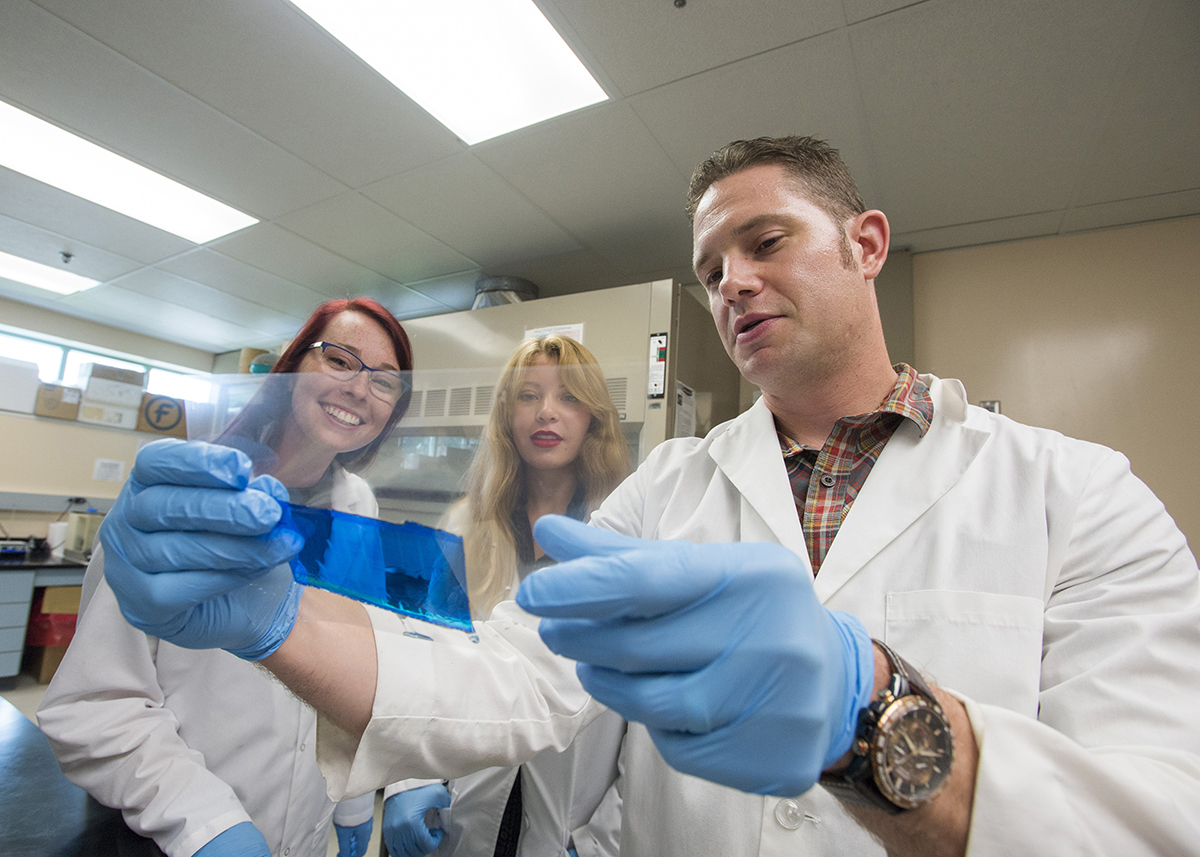
Derek Fisher, right, associate professor of microbiology at Southern Illinois University Carbondale, works with Tayla Harvey, left, and Ellen Werderitsch, center, both seniors in microbiology, in his laboratory. Fisher is teaming up with and Kyle Plunkett, associate professor of chemistry and biochemistry, to study ways to prevent chlamydia, a sexually transmitted disease that affects millions of people. Their work just received a second round of funding from the National Institutes of Health. The latest NIH grant of $442,000 brings the total to almost $860,000 since 2014 for the research. (Photo by Russell Bailey)
September 07, 2018
NIH grant funds chlamydia research
CARBONDALE, Ill. -- The scourge of chlamydia is well known. The sexually transmitted disease typically wreaks havoc on younger people in the prime of their lives, resulting in infertility and in some cases life-threatening conditions.
A record high of 1.7 million cases were reported to the Centers for Disease Control and Prevention in 2017, making it the leading reported bacterial sexually transmitted infection. Still, about two-thirds of those carrying it are not aware of it, meaning it is often left untreated and spreads easily.
Drug treatment is available, but reinfection is common, leading the CDC to recommend post-treatment testing. The large scope of the public health problem has led the research community to actively pursue improved treatment approaches and vaccines.
For all its ferocity, however, Chlamydia trachomatis cannot live on its own. It needs to hijack a healthy mammalian cell, which it then manipulates into feeding and sheltering it. Two researchers at Southern Illinois University Carbondale are investigating how chlamydia survives within host cells.
SIU researchers team up for answers
Derek Fisher, associate professor of microbiology, and Kyle Plunkett, associate professor of chemistry and biochemistry, have teamed up on the research, which just received a second round of funding from the National Institutes of Health. The latest NIH grant of $442,000 brings the total to almost $860,000 since 2014 for the research.
Fisher and Plunkett, along with graduate and undergraduate student researchers, are looking at a certain enzyme that that “flags” proteins by adding a phosphate molecule to them, as well as an enzyme that takes that molecule away. Such interactions – called phosphorylation – if better understood, could potentially lead to new drug therapies or vaccines that would prevent or better treat the disease.
Fisher and Plunkett aim to find a chemical means of interrupting this process, which relies on the lock-and-key relationships between certain proteins and enzymes. The researchers are looking at how the bacterium first infects a healthy cell, as well as how it replicates after doing so, and how it transitions back and forth between its two forms.
Disease needs healthy cells to survive
During infection, the infectious form of chlamydia, also known as the elementary body, first comes in contact with a healthy epithelial cell, where it uses a syringe-like projection to penetrate the cell membrane, allowing it to deliver specialized proteins inside it. These proteins cause the cell to take up the bacterium, surrounding it with its membrane in a new structure called an inclusion.
Once inside, the bacterium transitions into its reticulate body and begins to reproduce until it ruptures the cell and moves on to others, converting back to its infectious form, or elementary body, in the process.
“We don’t understand how the infectious form knows that it’s time to tell the cell to let it in, nor how it knows when it’s time to transition back and forth,” Fisher said. “Presumably there are signals it receives, but we don’t know the mechanics that allow it to make those transitions back and forth.”
Chemistry key to disrupting disease
The researchers’ overall approach is to determine how phosphorylation affects chlamydial growth and development. Phosphorylation has been increasingly recognized as a good method for regulating bacterial growth and survival and therefore understanding how a disease develops.
Attaching a phosphate group to a protein – which is performed by a protein kinase – can affect the function of the protein. The process can then be reversed by a protein phosphatase, which removes the phosphates from the protein. The working hypothesis is that disrupting either process would severely impair chlamydia’s ability to survive and spread.
“Chlamydia needs to manipulate a host cell’s metabolism to survive and grow,” Fisher said. “Our hypothesis is that this process is playing a role in the chlamydial regulatory process, telling it when to do what, and helping it do it.”
Focus on proteins
The study is focusing on three protein kinases and one protein phosphatase, all of which were identified as promising avenues of research during Fisher’s first round of funding in the area. One protein kinase in particular, known as Pkn5, is interesting, as it is the type being injected by the bacterium into the host cell via the syringe-like projection where it likely interferes with normal host process to the benefit of the bacterium.
Plunkett’s portion of the work will focus mainly on the synthesis of new molecules that can inhibit the protein phosphatase, known as CppA, and ways to inhibit its portion of the process. He is tweaking the molecular structure of molecules that the researchers have shown inhibit CppA in an effort to improve effectiveness.
“The shape of the molecule changes the way they can interact, like a lock and a key,” Plunkett said.
The grant will pay for lab consumables, conference attendance and publications to share results, and two or more graduate students and two undergraduate student research assistants for a three-year period.
